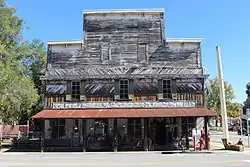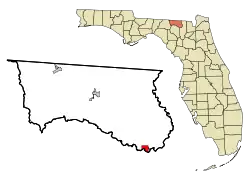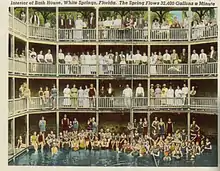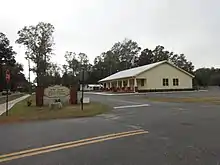White Springs, Florida
White Springs is a town in northern Florida on the Suwannee River. The population was 777 at the 2010 census,[4] down from 819 at the 2000 census. Home of the annual Florida Folk Festival, it is a tourist destination noted for historic charm, antique shops and river recreation.
White Springs, Florida | |
|---|---|
 Adams Country Store, White Springs | |
 Location in Hamilton County and the state of Florida | |
| Coordinates: 30°19′54″N 82°45′22″W | |
| Country | |
| State | |
| County | Hamilton |
| Incorporated | 1885 |
| Area | |
| • Total | 1.83 sq mi (4.74 km2) |
| • Land | 1.83 sq mi (4.74 km2) |
| • Water | 0.00 sq mi (0.01 km2) |
| Elevation | 112 ft (34 m) |
| Population (2020) | |
| • Total | 740 |
| • Density | 404.59/sq mi (156.22/km2) |
| Time zone | UTC-5 (Eastern (EST)) |
| • Summer (DST) | UTC-4 (EDT) |
| ZIP code | 32096 |
| Area code | 386 |
| FIPS code | 12-77400[2] |
| GNIS feature ID | 0293230[3] |
| Website | www |
History
The Suwannee River was once the boundary between the Timucuan peoples to the east and the Apalachee people to the west. When Spanish explorers visited the area in the 1530s, the spring was visited by natives from both sides of the river, who believed the water possessed healing powers. The Indians considered the spring a sacred healing ground, and used it even in times of war; any tribe member could bathe and drink the mineral waters without fear of being attacked.[5] The spring water has a "rotten egg" sulfur smell that comes from dissolved hydrogen sulfide gas.[6]
The settlement was incorporated in 1831 as "Jackson Springs" by businessmen Joseph Bryant, James T. Hooker, his brother William B. Hooker, John Lee, and James D. Prevatt. In addition to the spring, they planned to build a ferry across the Suwannee River.[7]
The following year, Bryant Sheffield purchased the ferry operation rights and the spring, then known as "White Sulpher [sic] Springs".[8][5] Sheffield drank the mineral waters and touted their ability to cure nervousness, kidney troubles, and rheumatism, among other problems. In 1842, he constructed a hotel and spring house from local timber.
During the Civil War, some Confederate soldiers found refuge in the town from Union troops. The family of future governor Napoleon Bonaparte Broward, whose Jacksonville farm was burned by Union forces, moved to a nearby farm which they named "Rebel's Refuge".[7] At some point, the springs were renamed "White Sulphur Springs".
Following the Civil War, the tourist business slowly returned. In 1882, the Georgia merchants Wight and Powell purchased the property and platted city lots. They sold parcels to other retailers to open businesses catering to plantations and resorts around the spring. Crowds of health seekers arrived, first by stagecoach and then railroad. White Springs was incorporated in 1885. Hotels and boarding houses popped up; a cotton gin attracted buyers and sellers; and fashionable clothing and hats were offered for sale. Leisure activities included ballroom dancing, lawn tennis, and skating.[7]

In 1903, the spring was enclosed by concrete and coquina walls that included multiple water gates and galleries to prevent water intrusion from river flooding. A four-story wooden bathhouse was constructed around the spring.[9] The structure was designed by the Jacksonville architectural firm McClure & Holmes for owner Minnie Mosher Jackson, and included doctors' offices for patient examination and treatment, dressing rooms, space for concessions, and an elevator.[10] At the time, water flow was calculated at 32,400 gallons per minute, or nearly 47 million gallons per day.[11]
During the 1930s, bathing in mineral springs fell out of favor in the United States and the town began to fade. In 1950, the Stephen Foster Memorial Museum opened to commemorate songwriter Stephen Foster, composer of the world-renowned song of the Suwannee River, "Old Folks at Home". The museum is surrounded by formal gardens which extend to the banks of the Suwannee River. A carillon containing the world's largest set of tubular bells, [12] opened in 1957 and plays Foster's songs throughout the day. The facility is a Florida State Park.
Through the 1980s, water flow at the spring declined to the point when it ceased flowing in 1990. The ex-mayor of White Springs, Dr. Helen Miller, was vice chairman of Florida Leaders Organized for Water (FLOW), a group which proposed the Floridan Aquifer Sustainability Act of 2013. The legislation seeks to restore the Floridan aquifer to 1980 levels.[13]
In 2022, a neo-pagan religion known as the Asatru Folk Assembly (AFA) dedicated a Viking neo-pagan temple in White Springs.[14] The temple is dedicated to the Viking god Njord and is called "Njordshof" which means "Njord's temple" in Old Norse, the language of the Vikings.[14]
Historic architecture
Many of the original Victorian buildings survive, particularly within the White Springs Historic District, established in 1997 by the National Register of Historic Places.[7]
Florida Folk Festival
The town and state park are the site of the annual Florida Folk Festival, a four-day celebration of traditional Florida food, arts, and music. The event, first held in 1953, is one of the oldest continuous folk festivals in the United States.[15]
Geography
White Springs is located in southeastern Hamilton County at 30°19′54″N 82°45′22″W (30.331647, –82.756008).[16] Its southern boundary follows the Suwannee River, which forms the border with Columbia County.
The town is crossed by U.S. Route 41 (SR 25 and 100) and SR 136. US 41 leads northwest 17 miles (27 km) to Jasper, the Hamilton County seat, and southeast 12 miles (19 km) to Lake City. SR 136 leads west 3 miles (5 km) to Interstate 75.
According to the United States Census Bureau, the town has a total area of 1.9 square miles (4.8 km2), of which 56,330 square feet (5,233 m2), or 0.11%, are water.[4]
Climate
| Climate data for White Springs 7N, Florida, 1991–2020 normals, extremes 1999–2020 | |||||||||||||
|---|---|---|---|---|---|---|---|---|---|---|---|---|---|
| Month | Jan | Feb | Mar | Apr | May | Jun | Jul | Aug | Sep | Oct | Nov | Dec | Year |
| Record high °F (°C) | 84 (29) |
85 (29) |
89 (32) |
94 (34) |
98 (37) |
102 (39) |
101 (38) |
103 (39) |
97 (36) |
94 (34) |
89 (32) |
85 (29) |
103 (39) |
| Average high °F (°C) | 65.6 (18.7) |
68.7 (20.4) |
74.7 (23.7) |
81.0 (27.2) |
87.3 (30.7) |
90.7 (32.6) |
93.0 (33.9) |
91.9 (33.3) |
88.7 (31.5) |
82.0 (27.8) |
74.3 (23.5) |
67.6 (19.8) |
80.5 (26.9) |
| Daily mean °F (°C) | 53.7 (12.1) |
57.0 (13.9) |
62.3 (16.8) |
68.5 (20.3) |
75.1 (23.9) |
80.2 (26.8) |
82.6 (28.1) |
82.0 (27.8) |
78.8 (26.0) |
70.7 (21.5) |
62.0 (16.7) |
56.1 (13.4) |
69.1 (20.6) |
| Average low °F (°C) | 41.8 (5.4) |
45.3 (7.4) |
49.9 (9.9) |
56.0 (13.3) |
62.9 (17.2) |
69.8 (21.0) |
72.2 (22.3) |
72.1 (22.3) |
68.8 (20.4) |
59.5 (15.3) |
49.7 (9.8) |
44.7 (7.1) |
57.7 (14.3) |
| Record low °F (°C) | 18 (−8) |
24 (−4) |
26 (−3) |
37 (3) |
46 (8) |
61 (16) |
56 (13) |
61 (16) |
53 (12) |
30 (−1) |
27 (−3) |
22 (−6) |
18 (−8) |
| Average precipitation inches (mm) | 4.62 (117) |
3.50 (89) |
4.21 (107) |
3.82 (97) |
3.48 (88) |
7.62 (194) |
5.87 (149) |
6.68 (170) |
5.21 (132) |
3.44 (87) |
2.23 (57) |
2.94 (75) |
53.62 (1,362) |
| Source: NOAA[17][18][19] | |||||||||||||
Demographics
| Census | Pop. | Note | %± |
|---|---|---|---|
| 1890 | 543 | — | |
| 1900 | 690 | 27.1% | |
| 1910 | 1,177 | 70.6% | |
| 1920 | 984 | −16.4% | |
| 1930 | 618 | −37.2% | |
| 1940 | 600 | −2.9% | |
| 1950 | 700 | 16.7% | |
| 1960 | 633 | −9.6% | |
| 1970 | 767 | 21.2% | |
| 1980 | 781 | 1.8% | |
| 1990 | 704 | −9.9% | |
| 2000 | 819 | 16.3% | |
| 2010 | 777 | −5.1% | |
| 2020 | 740 | −4.8% | |
| U.S. Decennial Census[20] | |||
2020 census
| Race | Num. | Perc. |
|---|---|---|
| Black or African American (non-Hispanic) | 393 | 53.11% |
| White (non-Hispanic) | 303 | 40.95% |
| Native American | 5 | 0.68% |
| Asian | 2 | 0.27% |
| Other/Mixed | 21 | 2.84% |
| Hispanic or Latino | 16 | 2.16% |
As of the 2020 United States census, there were 740 people, 382 households, and 218 families residing in the town.
2000 census
As of the census[2] of 2000, there were 819 people, 340 households, and 227 families residing in the town. The population density was 446.0 inhabitants per square mile (172.2/km2). There were 393 housing units at an average density of 214.0 per square mile (82.6/km2). The racial makeup of the town was 36.75% White, 62.15% African American, 0.37% Native American, and 0.73% from two or more races. Hispanic or Latino of any race were 0.37% of the population.
There were 340 households, out of which 33.5% had children under the age of 18 living with them, 36.2% were married couples living together, 26.2% had a female householder with no husband present, and 33.2% were non-families. 29.7% of all households were made up of individuals, and 12.1% had someone living alone who was 65 years of age or older. The average household size was 2.41 and the average family size was 2.93.
In the town, the population was spread out, with 30.3% under the age of 18, 10.4% from 18 to 24, 26.4% from 25 to 44, 20.8% from 45 to 64, and 12.2% who were 65 years of age or older. The median age was 32 years. For every 100 females, there were 85.3 males. For every 100 females age 18 and over, there were 75.7 males.
The median income for a household in the town was $24,861, and the median income for a family was $32,115. Males had a median income of $31,953 versus $21,250 for females. The per capita income for the town was $15,555. About 20.0% of families and 22.6% of the population were below the poverty line, including 22.3% of those under age 18 and 26.6% of those age 65 or over.
Education

The Hamilton County School District operates the public schools serving White Springs, Hamilton County Elementary School and Hamilton County High School, both in an unincorporated area of the county.
South Hamilton Elementary School in White Springs formerly served the city;[22] it was consolidated into a new elementary school, Hamilton County Elementary School,[23] located in an unincorporated area south of Jasper.[24] Its opening was scheduled for August 2017.[25]
The Suwannee River Regional Library System operates the White Springs Public Library.[26]
Gallery
 South Hamilton Elementary School (now closed)
South Hamilton Elementary School (now closed) White Springs Post Office
White Springs Post Office Historic Johns House
Historic Johns House Adams House in the historic district
Adams House in the historic district
See also
References
- "2020 U.S. Gazetteer Files". United States Census Bureau. Retrieved December 2, 2021.
- "U.S. Census website". United States Census Bureau. Retrieved January 31, 2008.
- "US Board on Geographic Names". United States Geological Survey. October 25, 2007. Retrieved January 31, 2008.
- "Geographic Identifiers: 2010 Demographic Profile Data (G001): White Springs town, Florida". American Factfinder. U.S. Census Bureau. Retrieved April 25, 2017.
- Staff. "The Spring House at Stephen Foster". Florida State Parks. Archived from the original on December 14, 2019. Retrieved December 14, 2019.
- Mark L. McFarland; T. L. Provin. "Hydrogen Sulfide in Drinking Water Causes and Treatment Alternatives and" (PDF). Texas A&M University. Retrieved December 14, 2019.
- "Town of White Springs - Our Town". www.whitesprings.org. City of White Springs. 2011. Archived from the original on February 4, 2013. Retrieved December 14, 2019.
- Territory of Florida (1842). Acts and Resolutions of the Legislative Council of the Territory of Florida Passed at Its Twentieth Session: Which Commenced on the Third Day of January and Ended on the Fifth Day of March, 1842. C.E. Bartlett. p. 15.
- "Interior of Bath House, White Springs, Florida". 191?. State of Florida, Division of Library and Information Services. Retrieved January 18, 2013.
- "History of White Springs Florida". Small Town Gems. Retrieved January 18, 2013.
- "Bath House, Spring Street, White Springs, Hamilton County, FL". Historic American Buildings Survey (Library of Congress). Historic Map Works. Retrieved January 18, 2013.
- "Stephen Foster State Folk Culture Center" Yahoo Travel
- Ritchie, Bruce (October 29, 2012). "White Springs mayor leads support for water legislation that seeks to protect springs". Florida Current. Retrieved January 21, 2013.
- http://www.njordshof.org/
- "About the Florida Folk Festival". Florida Folklife Collection. Division of Library & Information Services. Retrieved January 18, 2013.
- "US Gazetteer files: 2010, 2000, and 1990". United States Census Bureau. February 12, 2011. Retrieved April 23, 2011.
- "NOWData - NOAA Online Weather Data". National Oceanic and Atmospheric Administration. Retrieved June 24, 2021.
- "Summary of Monthly Normals 1991-2020". National Oceanic and Atmospheric Administration. Retrieved June 24, 2021.
- "xmACIS2". National Oceanic and Atmospheric Administration. Retrieved May 1, 2023.
- "Census of Population and Housing". Census.gov. Retrieved June 4, 2015.
- "Explore Census Data". data.census.gov. Retrieved December 18, 2021.
- Home. South Hamilton Elementary School. Retrieved on April 8, 2017.
- Taylor, Joyce Marie (June 12, 2014). "Hamilton: New site chosen for consolidated elementary school". Suwannee Democrat. Retrieved April 8, 2017.
- "Hamilton County set to break ground on new elementary school". WCTV. June 27, 2016. Retrieved April 8, 2017. "The groundbreaking ceremony will take place at 5686 U.S. Hwy 129 South in Jasper."
- "Hamilton: Culpepper/Gray selected to construct new elementary school". Suwannee Democrat. July 27, 2015. Retrieved April 8, 2017.
- Home page. White Springs Public Library. Retrieved on April 8, 2017.
External links
- Town of White Springs official website
- Florida Folk Festival
- Stephen Foster Folk Culture Center
- Homepage of the Florida Folklife Collection (housed at the State Archives of Florida) which includes thousands of images and recordings of the Florida Folk Festival; held annually in White Springs, Florida
